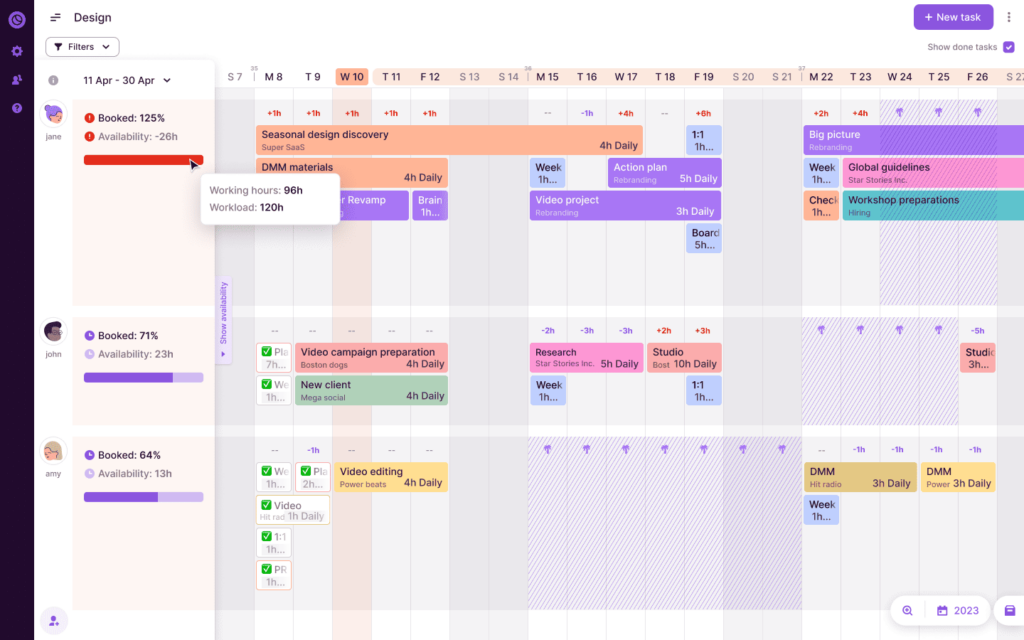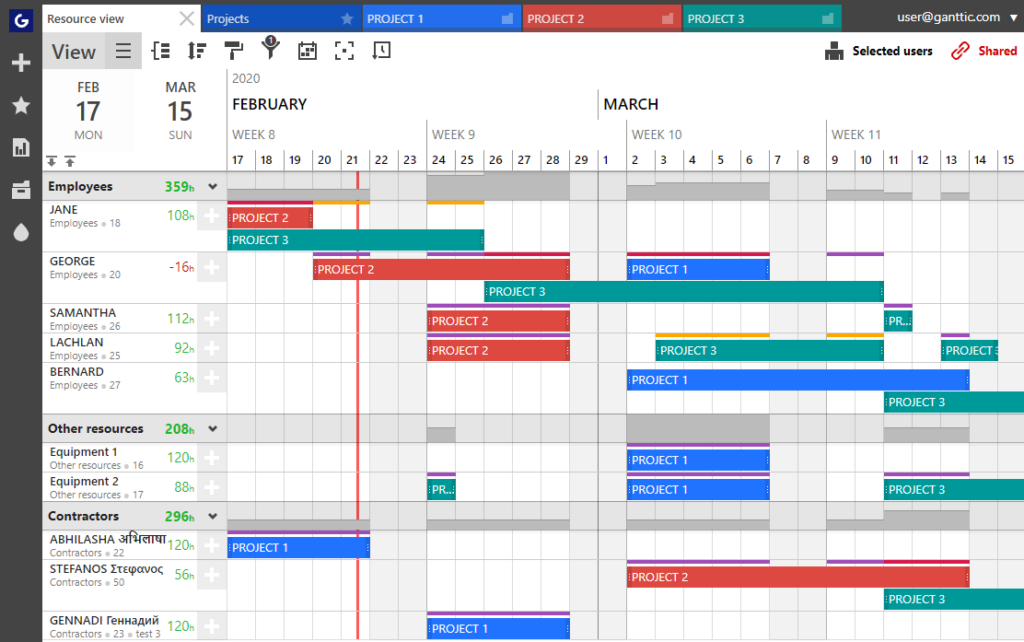Burnout in team members and missing deadlines are common issues for many project teams today. These bottlenecks can easily be solved with the right capacity planning tool.
The million-dollar question is: How do you know which capacity planning software suits your needs?
We want to help you answer this, so we compiled a list of the ten best capacity planning tools.
You’ll have the chance to explore key features, pros and cons, integrations, and pricing.
Disclaimer: The information below is accurate as of {publish date}.
What is the best capacity planning software?
Here’s our list of the best 10 tools:
- Toggl Plan
- Resource Guru
- Runn
- Float
- Kantata
- LiquidPlanner
- Wrike
- Ganttic
- Hub Planner
- SmartSheet
1. Toggl Plan
Price: Starts at $9/month

Toggl Plan is a capacity planning and resource management tool that makes it simple to track team availability, plan capacity, and allocate resources.
What we like
- Toggl Plan’s team timeline view provides a clear visual representation of team members’ workloads and schedules on a timeline.
It enables managers to easily see who is working on what, assess team capacity, spot overloads or underutilized periods, and make informed decisions for future planning.
What’s missing
- You can’t do scenario planning in Toggl Plan to see how different projects or tasks might affect your capacity.
Best for
Toggl Plan is best for professional service teams who need a simple yet powerful tool for planning team capacity, managing resources, and scheduling projects.
Top features
- Team timeline: Get a quick visual overview of team members’ tasks, schedules, and daily workloads.
- Availability Overview panel: This panel displays team members’ availability and booking percentage at a glance.
- Drag-and-drop scheduling: Easily and intuitively adjust tasks and timelines with Toggl Plan’s drag-and-drop scheduling.
- Project progress overview: Track project progress in real-time and get a clear view of task progress and what’s pending.
- Task estimates: Set time estimates for tasks and plan more accurately.
Tool integrations
Integrations include Toggl Track, Slack, and Google Calendar.
Pricing
Toggl Plan offers three pricing options with a free 14-day trial:
| Plan | Cost | Best for |
|---|---|---|
| Free | $0 per user | Solo users |
| Team | $9 per user per month | Teams who need to meet deadlines and manage resources effectively |
| Business | $15 per user per month | Teams who work with external stakeholders and need seamless reporting features |
2. Resource Guru
Price: Starts at $5/month

Resource Guru is a resource management tool that helps teams schedule resources, plan capacity, and manage workloads.
What we like
- Resource Guru generates project forecasting and resource utilization reports. This way, you can get high-level visibility into current capacity and see who’s under or overworked. You can also add custom fields and filters to get any specific data you need.
What’s missing
- Resource Guru lacks Gantt chart functionality, which is important for easily visualizing, editing, and planning team capacity. Also, Resource Guru doesn’t have a free plan.
Best for
Resource Guru is best for teams who need a capacity planning and resource management tool with powerful project forecasting reports.
Top features
- Multi-resource bookings: Easily create bookings for multiple people simultaneously and save time.
- Advanced clash management: Get booking clash notifications and avoid overbooking team members.
- Vacation tracker and absence management: Track days off so you can plan capacity and projects accurately.
- Availability Bar: See at a glance how much free and booked time each of your team members has.
Tool integrations
Integrations include Google Calendar, Outlook, and Zapier.
Pricing
Resource Guru offers three pricing plans:
| Plan | Cost | Best for |
|---|---|---|
| Grasshopper Plan | $5 per user per month | Teams who need essential features and don’t need reports |
| Blackbelt Plan | $8 per user per month | Teams who need the standard features plus reports |
| Master Plan | $12 per user per month | Teams who need SSO, data imports, and phone support |
Visit the pricing page for more information.
3. Runn
Price: Starts at $10/month

Runn is a capacity planning tool that helps team leads and managers optimize their resource allocation and project forecasting.
What we like
- Runn has a scenario planning feature that lets you prepare for “what-if” scenarios.
You can create tentative projects (projects that are not yet confirmed) and analyze their impact on your capacity by toggling them on and off individually. You’ll get real-time graphs that show how tentative projects affect your capacity, availability, or utilization.
What’s missing
- Runn doesn’t let you estimate task durations, which can improve how you plan project resources and team capacity.
Best for
Runn is best for teams who need strong real-time features to forecast projects and capacity.
Top features
- People Planner: View your team’s workload, availability, and utilization, and plan project resources with confidence.
- Drag-and-drop scheduling: Schedule projects and resources, edit, and reassign tasks with drag-and-drop functionality.
- Time off management: Easily track and organize employee leave requests and plan with time off in mind.
- Powerful reporting: Generate effective capacity, remaining availability, or total utilization reports for key workload metrics.
Tool integrations
Integrations include BambooHR, Clockify, and Workday.
Pricing
Runn offers three pricing plans:
| Plan | Cost | Best for |
|---|---|---|
| Free | $0 per user | Teams who need unlimited users and projects |
| Pro | $10 per user | Teams who need Integrations, demand forecasting, timesheets, and API access |
| Enterprise | Contact Runn | Enterprise teams |
Visit the pricing page for more information.
4. Float
Price: Starts at $7.50/month

Float is a popular capacity planning tool with built-in time tracking. It helps teams monitor work hours and plan capacity and projects accordingly.
What we like
- Float lets you easily set custom work hours for part-time employees or freelancers. Add their working days and hours and edit their availability based on specific contract arrangements.
What’s missing
- Float doesn’t come with a free plan.
Best for
Float is best for teams who need a capacity planning tool with built-in time tracking to monitor work hours and schedule projects.
Top features
- Time off and calendar sync: Track and manage time off and integrate calendar events to manage team capacity accurately.
- Tentative planning: Create tentative projects to see how many team members you need for your next project. You can also get an idea of the specific project roles you need and if they’re available.
- Utilization rates: Easily visualize productivity at an individual and team level.
- Built-in time tracking: Track work hours to better understand where your team’s time goes and how much time tasks take.
Tool integrations
Integrations include Google Calendar, Asana, and Slack.
Pricing
Float offers three pricing plans:
| Plan | Cost | Best for |
|---|---|---|
| Starter | $7.50 per user per month | Teams up to 30 members who need capacity management and resource scheduling features |
| Pro | $12.50 per user per month | Growing teams who need built-in time tracking |
| Enterprise plan | Contact Float | Enterprise teams |
Visit the pricing page for more information.
5. Kantata
Price: Custom quotes

Kantata, formerly known as Mavenlink, is a visual capacity planning tool with strong real-time reporting features for resources, work hours, and project progress.
What we like
- Kantata is a highly visual tool that lets you easily visualize project progress, resource availability, and capacity. You get a visual overview of your team’s availability, productivity, and capacity through charts, graphs, and diagrams.
What’s missing
- According to some users, Kantata’s mobile app is not user-friendly or fully optimized for mobile.
Best for
Kantata is best for teams who need to plan team capacity with a visual tool and access to real-time reports.
Top features
- Resource dashboard: Forecast billable capacity, view daily schedules, weekly or monthly availability, all from a single place.
- Capacity scenario: In the Capacity Scenario tab, you can simulate different scenarios to understand their impact on capacity.
- User availability reports: Get a detailed, week-by-week view of availability, broken down by both individual users and roles. See who is available, who is at full capacity, and who is exceeding their capacity.
- Time off management: See and manage your team’s PTO, sick leave, and public holidays for more accurate capacity planning.
Tool integrations
Integrations include Slack, Jira, and HubSpot.
Pricing
Kantata doesn’t publicly display its pricing plans. You have to get in touch with them and request a tailored quote.
6. LiquidPlanner
Price: Starts at $15/month

LiquidPlanner is a predictive project scheduling tool that helps teams plan projects with confidence.
What we like
- LiquidPlanner’s intelligent predictive scheduling engine creates realistic project forecasts. It calculates project start and end dates using an advanced algorithm, which factors in priorities, dependencies, limits, target dates, and team member availability.
What’s missing
- One thing many users complain about is that reports in LiquidPlanner can’t be exported in PDF format.
Best for
LiquidPlanner is best for teams who need a predictive scheduling tool to help plan projects and resources.
Top features
- Forecasting engine: LiquidPlanner automatically predicts schedule dates for your entire portfolio.
- Availability and vacations: Get availability insights for the next 60 days and see who’s off so you can assign tasks realistically.
- Integrated time tracking: Use time tracking data to plan projects and estimate future work durations.
- Automatic resource leveling: LiquidPlanner dynamically adjusts the schedule to align with your priorities and constraints.
Tool integrations
Integrations include Google Drive, Dropbox, and Zapier.
Pricing
LiquidPlanner offers three paid plans:
| Plan | Cost | Best for |
|---|---|---|
| Essentials | $15 per user per month (with annual billing) | Mid-sized teams who need essential project management |
| Professional | $28 per user per month (with annual billing) | Teams who need access to more planning features, including project timelines, custom codes, and fields |
| Ultimate | $42 per user per month (with annual billing) | Enterprise teams |
Visit their pricing page for more information.
7. Wrike
Price: Starts at $9.80/month.

Wrike is a resource management software tool that helps plan team capacity with features like resource view, team utilization dashboard, and effort allocation.
What we like
- Through Wrike’s workload view, team leads and managers can quickly check each team member’s availability and plan capacity accordingly.
What’s missing
- Advanced resource and capacity planning features like job roles, resource bookings, and team utilization dashboard are only available in the Pinnacle plan.
Best for
Wrike is best for teams who need a resource management tool to help them plan team capacity and deliver projects on time.
Top features
- Team utilization dashboard: View overall team utilization, compare measured vs actual team or individual utilization, and track billable utilization.
- Job roles: Create custom job roles and allocate them to your team members to streamline future effort planning and allocation.
- Workload Charts: Wrike’s Workload Charts provide a visual overview of individual team members’ tasks and responsibilities.
- Resource view: Gain detailed insights into project resources and their allocation, and manage your team’s time and skills across different projects.
Tool integrations
Integrations include Google Calendar, Slack, and Stripe.
Pricing
Wrike offers five pricing options:
| Plan | Cost | Best for |
|---|---|---|
| Free | $0 | Solos users who need centralized task management |
| Team | $9.80 per user per month | Small teams who need effective team management and data-driven planning |
| Business | $24.80 per user per month | Teams who need an intelligent platform for any use case |
| Enterprise | Contact Wrike | Enterprise teams |
| Pinnacle | Contact Wrike | Enterprise teams with complex needs |
Visit the pricing page for more information.
8. Ganttic
Price: Starts at $1.25/month per resource

Ganttic is an online resource capacity planner with features for scheduling, tracking, and managing resources and projects.
What we like
- Ganttic lets you customize and take full control of your planning process. For specific planning, you can easily create custom data fields with client info, milestones, and other key project data.
You can also create custom views so you can visualize your projects and resources exactly as you need.
What’s missing
- Ganttic doesn’t show real-time data about how different scenarios might impact your capacity or delivery.
You can only create unassigned tasks in Ganttic and use them to see how they might affect team capacity.
Best for
Ganttic is best for teams who need a highly customizable resource capacity planning tool with Gantt chart functionality.
Top features
- Drag-and-drop scheduling: Easily move things around, reassign tasks, or change task durations with drag-and-drop functionality.
- Utilization reporting: See your team’s short- and long-term availability with resource utilization graphs and percentage trackers.
- Future capacity forecasting: Predict and plan for future resource availability and utilization.
- Custom data fields: Make your capacity planning process yours by customizing it with specific info.
Tool integrations
Integrations include Google Calendar, Outlook, and Zapier.
Pricing
Ganttic’s pricing is resource-based, meaning you only pay for human and non-human resources and not for users. Also, the more resources you pay for, the lower the price per resource.
For up to 10 resources, Ganttic is free.
Here’s the most popular Ganttic pricing plan:
| Plan | Cost | Best for |
|---|---|---|
| Up to 250 resources | From $0.92 per month per resource | Teams who need to manage lots of resources |
Visit the pricing page for more information.
9. Hub Planner
Price: Starts at $7/month

Hub Planner is a resource management and scheduling tool that helps spot overbooked resources, avoid scheduling conflicts, and plan capacity.
What we like
- With Hub Planner’s capacity finder feature, you find available resources faster. It filters available team members over specific time periods.
What’s missing
- For access to vacation and leave management, capacity finder, and custom fields, Hub Planner costs $18 per user per month.
Best for
Hub Planner is best for medium and large-sized teams who need detailed resource scheduling features.
Top features
- Capacity finder: Plan and forecast capacity by filtering schedules based on availability or utilization for a specific time range.
- Resource scheduler: Hub Planner’s drag-and-drop scheduler lets you see time off at a glance, zoom in and out, and manage schedule conflicts.
- Skills matching with custom fields: Create skill fields specific to your industry and team. When planning capacity, you can easily search for specific skills you need and see their availability.
- Heat map reports: Get a quick overview of your team’s availability and see who’s got too much or too little work.
Tool integrations
Integrations include Google Calendar, Hub Planner API, and Zapier.
Pricing
Hub Planner offers three pricing plans:
| Plan | Cost | Best for |
|---|---|---|
| Plug & Play | $7 per user per month | Scaling teams who need to schedule and manage resources |
| Premium | $18 per user per month | Medium and large-sized teams who need advanced resource management features |
| Business Leader | Contact Hub Planner | Enterprise teams |
Visit the pricing page for more information.
10. Smartsheet
Price: Starts at $9/month

Smartsheet is project management software that combines the flexibility of a spreadsheet interface with features like dynamic resource planning, Gantt charts, and utilization heat maps.
What we like
- Smartsheet has lots of capacity planning templates to help you quickly start capacity planning without building everything from scratch, saving time and effort.
What’s missing
- Smartsheet doesn’t have scenario planning which can be a helpful feature for realistic capacity planning.
Best for
Smartsheet is best for teams who want a spreadsheet-based resource management tool.
Top features
- Dynamic resource planning: Plan resources, spot issues, and solve them quickly.
- Utilization heat maps: See team member availability one year into the future to plan on the long term.
- Kanban boards and Gantt charts: Visualize and plan resources with intuitive and easy-to-use Kanban boards and Gantt charts.
- Capacity planning templates: Choose from human resources capacity planning, project capacity planning, or team capacity planning templates.
Tool integrations
Integrations include Slack, Outlook, and Zapier.
Pricing
Smartsheet offers four pricing plans:
| Plan | Cost | Best for |
|---|---|---|
| Free | $0 for 1 user | Resource management beginners |
| Pro | $9 per user per month | Teams who need access to capacity planning templates and utilization reports |
| Business | $32 per user per month | Teams who need lots of integrations |
| Enterprise | Contact Smartsheet | Enterprise companies |
Visit the pricing page for more information.
Best capacity planning tools: A quick comparison
Here’s a quick big-picture overview of our top 10 capacity planning tools:
| Tool | G2 Rating | Best for | Price |
|---|---|---|---|
| Toggl Plan | 4.3 | Resource management and capacity planning | From $9 per user/month |
| Resource Guru | 4.7 | Project forecasting | From $5 per /month |
| Runn | 4.5 | Scenario planning | From $10 per /month |
| Float | 4.2 | Capacity planning with built-in time tracking | From $7.5 per /month |
| Kantata | 4.2 | Visual capacity planning | Custom pricing |
| LiquidPlanner | 4.2 | Predictive project scheduling | From $15 per /month |
| Wrike | 4.2 | Powerful automation | From $9.80 per user/month (billed annually) |
| Ganttic | 4.0 | Customizable capacity planner | From $1.25/month per resource |
| Hub Planner | 4.2 | Resource management and scheduling | From $7 per /month |
| Smartsheet | 4.4 | Project planning and management | From $9/month |
How do I choose the best capacity planning software?
We’ve asked some software experts about the most important criteria for choosing a capacity planning tool.
Here are the things they ranked most important:
- User-friendly: Fawaz Naser, product and software implementation expert at Softlist.io, said a capacity planning tool should be easy to use.
“A decent capacity planning software has to be easy for anyone to use. People working with it aren’t likely to be experts in everything they’re looking at, so it needs to make the data and processes simple for anyone to understand.”
- Predictive: He also explained why capacity planning software should be predictive.
“The main goal of capacity planning is to predict the future. This means the tool should let you play out different scenarios and see what might happen. Like, a manager might want to see the effects of doubling sales in a year, or growing the client base by 15%.”
- Scalable: According to Geoffrey Bourne, co-founder of Ayrshare, good capacity planning software is scalable.
“You may have a small team right now or be working on basic projects, but visualizing where you’ll be in the next two to three years will enable you to choose the right product. Look for features like forecasting, scenario modeling, as well as the ability to handle large volumes of data.”
Frequently Asked Questions (FAQs)
Let’s look at some common questions people ask about capacity planning software.
What are capacity planning tools?
Capacity planning tools are apps that help you manage workloads, predict future project resource needs, and allocate resources effectively.
What is the best tool for capacity planning?
The best capacity planning tool for you depends on your specific needs, budget, and use cases. Top capacity planning software on the market comes with robust forecasting, real-time analytics, customizable reporting, and integration capabilities.
What are the benefits of using capacity planning software?
Using capacity planning software, you can optimize resource allocation, improve efficiency, reduce costs, and accurately forecast future needs.
The bottom line
Did any of these tools look like a good fit for you?
If you want to give them a try, you can start with Toggl Plan.
Sign in for a free Toggl Plan account and discover how it can help you:
- Easily understand team capacity and availability
- Avoid overbooking or underbooking
- Allocate resources effectively and meet project deadlines
Related articles:
- Best Workload Management Software
- Free Resource Planning Templates for Project Teams
- Capacity Planning Strategies: Types, Examples, Pros And Cons
Work tools to elevate your productivity – apps for incredibly simple time tracking and effective project planning.

